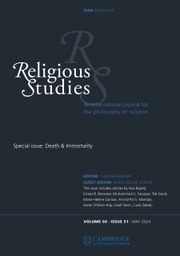Errors were introduced into the article during the production process. The corrected text is shown here.
Eighth page, third paragraph, the reference should read Jeanine Diller and Asa Kasher (2013, 2).
Fourteenth page should be numbered as.
(1*) IBEs are unreliable to establish the (probable or approximate) truth of (the central claims of) any hypothesis concerning ultimate reality if we cannot be reasonably sure that we have (sufficiently) exhausted the space of serious, well-supported, and distinct alternative hypotheses concerning ultimate reality, on the basis of which we conclude that (the central claims of) the hypothesis that provides the best explanation for the evidence are/is (probably or approximately) true.
(2*) We cannot be reasonably sure that we have (sufficiently) exhausted the space of serious, well-supported, and distinct alternative hypotheses concerning ultimate reality.
(3*) Therefore, IBEs are unreliable to establish the (probable or approximate) truth of (the central claims of) any hypothesis concerning ultimate reality.
Twenty-third page, sixth paragraph should read.
Concerning the third kind of evidence, we see a slight shift in emphasis. Although it is still a two-step strategy, first arguing that the apparent fine tuning of the universe needs explanation, the second step consists in arguing that pantheism provides the best explanation: the apparent fine tuning of the universe can ‘best be explained’ by axiarchic pantheism.
Twenty-fourth page, second paragraph [final sentence] should read [instead of “alternativehypotheses”]: alternative hypotheses concerning ultimate reality or concepts of God that are also serious, well-supported, and distinct, but either unconsidered or unconceived.
Reference section should read as, Denzinger H (2012) Compendium of Creeds, Definitions, and Declarations on Matters of Faith and Morals. Edited by Hünermann P. Translated by Fastiggi R and Englund Nash A. San Francisco: Ignatius Press.
The Publisher apologises for the errors.


